Address any questions or comments regarding this newsletter to the individual authors listed after each article or to its editors, Nathan Johanning, 618-939-3434, njohann@illinois.edu or Bronwyn Aly 618-695-6060, baly@illinois.edu. The Illinois Fruit and Vegetable News is available on the web at: http://ipm.illinois.edu/ifvn/. To receive or be removed from email notification of new postings of this newsletter, contact Nathan Johanning or Bronwyn Aly at the phone numbers or email addresses above.
In This Issue:
Upcoming Programs ((listings for beginning and established growers))
News & Announcements ((Grower Soil Samples Needed for Copper Screening Research Project, Information on the Illinois Farm to School Network; Requirements for Exempt Farms Under the FSMA Produce Rule))
Regional Reports ((west central (X2), east central Illinois, St. Louis Metro East, southern Illinois, Dixon Springs))
Fruit and Vegetable Pest Management ((New Grape Production Videos, Pumpkin Disease Management))
Upcoming Programs
Check the Illinois SARE calendar for a full list of programs and links for registration.
http://illinoissare.org/ and http://illinoissare.org/calendar.php
Also see the University of Illinois Extension Local Food Systems and Small Farms Team’s website at:
http://web.extension.illinois.edu/smallfarm/ and the calendar of events at http://web.extension.illinois.edu/units/calendar.cfm?UnitID=629.
- 2019 Southern Illinois Summer Twilight Meeting Jackson County Extension Office, Monday, August 19, 2019 at 6 p.m. For more information or to register, please contact Nathan Johanning at njohann@illinois.edu; 618-687-1727 or Bronwyn Aly, baly@illinois.edu; 618-252-8391.
- 2019 HerbFest, Saturday, August 24, 2019 from 9:00 am to 3:00pm. The Illinois Herb Association will host the 2019 HerbFest at the Reddick Mansion & Gardens, 100 West Lafayette Street, Ottawa, Illinois on Saturday, August 24. Join us for a day filled with informational speakers, workshops, exhibitors, and a self-guided tour of the Reddick’s gardens. Following the 2019 HerbFest, consider taking a self-guided tour of the beautiful downtown Ottawa gardens. The HerbFest agenda will be placed on our Facebook page as it is completed. Click on and “LIKE” us at https://www.facebook.com/IllinoisHerbAssociation for up-to-date information. For additional information or to register, contact Charlene at 309-557-2107 or Cblary@ilfb.org. For information regarding Reddick Mansion, click here: http://reddickmansion.org/.
News & Announcements
Grower Soil Samples Needed for Copper Screening Research Project
Researchers in the Department of Crop Sciences at the University of Illinois Urbana-Champaign are looking for vegetables and fruit growers to participate in a state-wide screening for soil copper build-up. Use of copper-based fungicides and bactericides such as Bordeaux mix, Kocide, Champ, Tenncop, Nordox, and Cueva can lead to accumulation of copper in soils. In regions of Australia and Europe, repeated use of copper to control crop pathogens has led to copper accumulation in soils that has compromised soil fertility. However, little is known about copper accumulation in the US, including Illinois. As a first step to assessing this potential issue in Illinois, U of I researchers are looking to test soils across the state for potential build-up of copper.
To this end, U of I researchers are offering a free screening of soils for copper (total concentration). There are two ways to be involved: (1) sample mail-ins, or (2) on-farm sampling by the U of I team. In both cases, you will be provided with a free soil copper test as well as a soil fertility test (pH, CEC, Mehlich-extractable nutrients, texture) will be provided free of charge.
For mail-ins: At least 1 cup of dry soil should be sampled as a composite from an area of interest. Up to 10 samples per grower will be screened at no cost. Contact information, including email, should be included so that results can be communicated. Soil samples should be packed in a sealable plastic bag and mailed to:
Soils Lab Attn: Strehl
1010 Plant Sciences Laboratory
1201 S Dorner Drive
University of Illinois Urbana-Champaign
Urbana, IL 61801
For on-farm visits: Please contact Taylor Strehl (strehl2@illinois.edu) to arrange a visit to your field(s) with past or current copper fungicide useage for more detailed by-field soil sampling and analyses.
Andrew Margenot, Assistant Professor of Soil Science (2173007059; margenot@illinois.edu)
Information on the Illinois Farm to School Network
Have you engaged with Illinois Farm to School yet? Why should you market your products to Illinois schools? Why market your products to schools?
- Provides steady, high-volume market
- Diversifies your market channels
- Provides outlet for selling cosmetically imperfect produce
- Spreads farm recognition across community (including staff, teachers, & parents)
- Way more than just K -12 schools
- Grows demand from the next generation!
Illinois Farm to School has opportunities for specialty growers to get involved with their local community in a variety of ways. On the website we have a complete tool kit with a section just for Farmers and Producers. The page includes helpful information on: finding schools, building relationships, Food Safety resources, logistical support, and much more. Selling to schools and institutions saves you time and travel to multiple markets allowing you more time to do what you do best….. growing food!
The Illinois Farm to School Network brings local food, school & community gardens, and food and nutrition education together in a powerful and profitable way to benefit all Illinois residents.
Farm to School has been a growing movement in the state of Illinois for over a decade, with many dedicated people and groups working together for our students. Now more than ever before, Farm to School is growing across the country. Illinois is a part of that growth. With every new school garden, every new food tasted, and every farmer now able to sell local products to school districts, we are creating a better food system.
There are several ways to get involved. If your local school district isn’t already involved, a wonderful one-day event is “The Illinois Great Apple Crunch.” It is a day-long celebration of fresh, local apples. This year is takes place on Thursday, October 10, 2019 (although your school/organization can choose to do it any day in October.) Any site including: K-12 schools, early childcare settings, boarding facilities, Juvenile Justice Centers, summer camps, summer feeding sites, after school programs, hospitals, colleges/universities, business campuses, state agencies and other organizations can participate.
If you would like more information about how to engage with the Illinois Farm to School Network I encourage you to drop me a line at mary@sevengenerationsahead.org, I’d love to help you!
Mary Hosier
Illinois Farm to School Network Coordinator
Seven Generations Ahead
1049 Lake Street, Suite 200
Oak Park, Illinois 60301
708 660-9909 x 5
mary@sevengenerationsahead.org
www.sevengenerationsahead.org
Requirements For Exempt Farms Under FSMA Produce Rule
Are you fully exempt or qualified exempt from the Food Safety Modernization Act (FSMA) Produce Rule? Do you know how to figure this out? If not, you are not alone! Did you know that even if you are exempt, you still have guidelines and requirements that need to be followed?
The Food and Drug Administration (FDA) has developed a flow chart to help growers determine whether they are fully exempt or qualified exempt from the FSMA Produce Rule. In the flow chart, they discuss “rarely consumed raw” produce, which is an exhaustive list developed by FDA. Basically, if your specialty crop is not on this list, then it is a covered produce under the FSMA Produce Rule.
Let’s break this down and make it a little easier to understand:
- Are you fully exempt?
If you are fully exempt, you are not required to attend the full-day Produce Safety Alliance grower training class, you are not required to maintain documentation or records for the farm, and you are not required to test your water source. However, FDA has determined that fully exempt farms will need to show their exemption status if/when a farm inspection is scheduled.
The records that they will be looking for will be your daily/weekly/monthly/yearly documentation of sales records to your customers. Since the definition of an exempt farm is having sales less than $25,000 (adjusted for inflation) in produce sales over a three-year average (produce includes fruits, vegetables, peanuts, tree nuts, herbs, mushrooms, and the plants they come from), the farm will need to keep records going back at least three years. Annual review and verification of sales status for the farm should be completed.
The North Central Region Center for FSMA Training, Extension and Technical Assistance group has develop a FSMA Exemption Worksheet that can be used to help determine the three-year average for the farm. This form can also be incorporated as the yearly review documentation for the farm.
Keep in mind, if your farm diversifies or grows, and your three-year average goes above the $25,000 (adjusted for inflation), the farm may fall under the FSMA Produce Rule, which will then require:
- At least one person from the farm to have completed the PSA grower training class
- Have documentation/records required by the Produce Rule
- Have results of the water testing requirements
- Are you qualified exempt? The Food and Drug Administration (FDA) has developed a flow chart to help growers determine whether they are fully exempt or qualified exempt from the FSMA Produce Rule. To be qualified exempt you must:
- Have less than $500,000 in food sales over a three-year period (food sales includes fruits, vegetables, peanuts, tree nuts, herbs, mushrooms, and the plants they come from as well as all other consumables such as candy, jams, ice cream, canned goods, meats, value-added products, grains for meat/dairy production, produce purchased from neighboring farms to sell off your farm, etc)
- The farm must sell at least 51% of food sales to qualified end users. Qualified end users are the consumer of the food, or restaurants, or retail food establishments that are located in the same state or Indian reservation as the farm, or not more than 275 miles from the farm. These can be buyers at a farmers market, Community Supported Agriculture (CSA) shareholders, a restaurant, grocery store or school cafeteria.
If you are qualified exempt, you are not required to attend the full-day Produce Safety Alliance grower training class, you are not required to maintain documentation or records for the farm, and you are not required to test your water source. However, FDA has determined that qualified exempt farms will need to show their exemption status if/when a farm inspection is scheduled.
All qualified exempt farms need to perform and document an annual review and verification of their qualified exemption eligibility. Dated sales receipts must be kept demonstrating that the farm satisfies the criteria for a qualified exemption – which can include invoices that show to whom products were sold. Individual receipts do not need to be signed by the farmer, but the annual review document does need to be reviewed, dated, and signed by a supervisor or responsible party within a reasonable time after the records are made.
Keep in mind, a farm’s qualified exemption may be withdrawn if there is an active investigation of an outbreak of foodborne illness that is directly linked to the farm, or if FDA determines it is necessary to protect the public health and prevent or mitigate an outbreak based on conduct or conditions associated with the farm or produce. If this happens, then the farm will no longer be exempt, and will need to meet the standards required under the Produce Rule. This will include:
- At least one person from the farm to have completed the PSA grower training class
- Have documentation/records required by the Produce Rule
- Have results of the water testing requirements
Whether the farm is fully exempt or qualified exempt, all produce growers must display the name and business address of the farm where the produce was grown - at the point of sale if a label is not attached to the produce, or on the label itself as required by the FDA. In the case of internet sales, the name and address of the farm where the produce was grown is required, and can be incorporated onto the electronic receipt.
So, after all this, what is the take-away message? First, make sure you know whether you farm is fully exempt, qualified exempt, or covered under the FSMA Produce Rule. If your farm does not fit into the designations above, there is a good chance that it will fall under the FSMA Produce Rule. Second, even if your farm is fully exempt or qualified exempt, it is important to learn more about the FSMA Produce Rule through a Produce Safety Alliance Grower Training course or the Good Agricultural Practices Online Program through Cornell University. You will be amazed at what you can learn!
Laurie George (618-548-1446; ljgeorge@illinois.edu)
Regional Reports
From west central Illinois (Macomb)…We knew it was coming. Groaning enough about all that rain, now we can groan about it being hot and dry. Finally, the irrigation system was turned on July 2 after a rainy spring that will be remembered for lifetimes. In fact, after finishing this update, I’ll head out to my former high tunnel and run more drip irrigation to the sweet potatoes and cucumbers.
Yes, I said former high tunnel. After six years, it was time to retire the tunnel. The poly plastic had suffered quite a bit of abuse from a nearby sycamore tree. Moreover, this was the poly plastic’s second life, after being donated to me by retired Extension educator Mike Roegge. I took that plastic and pushed it beyond its intended life. Thanks Mike!
There has been some catch-up with all the weeds. My rows have been getting hit with the flame weeder followed by covering with landscape fabric, while the beds are getting the attention of the long-handled wire weeder at least once per week.
Garlic is ready for harvest. The handful of samples I pulled today look very nice. Growers are harvesting tomatoes from the high tunnel. Meanwhile, tomatoes grown in the field has developing fruit, but remains green. Our pole beans are late, but it somewhat works out with Japanese beetles showing up July 1 and they have commenced doing what they do best, eating virtually everything. Since our beans are nowhere near harvest, we’ve been able to spray, but the heat and consistent irrigation should mean we’ll be picking beans in a little over a week or two and will need to watch the post-harvest interval.
Chris Enroth (309-837-3939; cenroth@illinois.edu)
From west central Illinois (Quincy)… As I write this on July 16, what a difference a month can make! 30 days ago we were praying for the rain to cease, and apparently someone heard us, as we’ve only gotten 0.4” since June 26, and the crops are certainly noting it! We have missed all those spotty rains. Lawns are turning brown and good sized cracks are very apparent across the soil.
We started picking sweet corn on July 8th, and the first crop is really good. Across the area, any early planted crops look good, but the late planted crops (including field corn and soybean) aren’t really growing, but instead are just (patiently?) waiting for some rain so they can grow. Their root systems aren’t developed enough to reach the moisture so deep in the soil, so they are just sitting and waiting. How long they can wait will be the question.
Our captures of corn earworm moth were very high until last week when they came down from an excess of 100 per night to 25 per night to just a few. Now that some of the field corn is also silking the moths have alternative locations in which to lay eggs, which lessens the numbers on our sweet corn. So now the spray schedule has loosened up a bit.
The 2nd, 3rd and 4th sweet corn plantings are very erratic in size/growth, depending upon how well drained the area of the field was. We were fortunate in that the first planted on was ground we have tiled at a 35’ lateral spacing, which allowed us to get it planted. We do have one field which we’ll abandon due to such a poor stand due to the excess rains. We will finish up with the first planted sweet corn the end of this week and will not be picking again until at least a week after, due to rains and the inability to plant timely.
We planted our main pumpkin crop on June 11-14, but then we received over 6” of rain from the 15th to the 22nd, which caused a loss of soil oxygen and we ended up with anywhere from 10-25% stand in fields. We replanted on June 26, and like I mentioned earlier, have only had two rains equaling 0.4” since. Needless to say, some of the replant didn’t make it, but we have enough of a stand I believe we can cope. We are going to start running trickle line on some of the pumpkins next week if need be.
I’ve treated for aphid, mite and tomato worms once this year in our tunnels, and noticed aphids again, so I’ll have to retreat soon. We alternate aphid and mite insecticides to reduce chances of resistance. High tunnel tomatoes are selling quicker than we can pick them as homegrown were planted so late that most have not come on yet.
I believe this is one of the best cauliflower and cabbage years we’ve had. The cool early weather really favored development of those crops, and as long as the caterpillars were kept in check, the crop turned out very decent. The broccoli was great also, until the hot weather caused bolting to occur, and no one wants to buy “uncommon looking” broccoli.
Mike Roegge, Retired Extension Educator & Mill Creek Farms (roeggem@illinois.edu)
From east central Illinois… It is a tale of two different stories, one is drought and one is flood. For the past three weeks, the rainfall patterns have been wetter in eastern side of the state and spotty in the central areas. Some commercial growers in central Illinois are having a difficult time keeping with the water needs for plants with their drip irrigation systems due to the high heat and lack of any rainfall.
In the past two weeks, a lot of dicamba applications have been made in late planted soybean fields and with the recent high temperatures in the low 90’s. I am seeing symptoms of plant growth regulator herbicide damage in vegetables, fruits and ornamentals across the area.
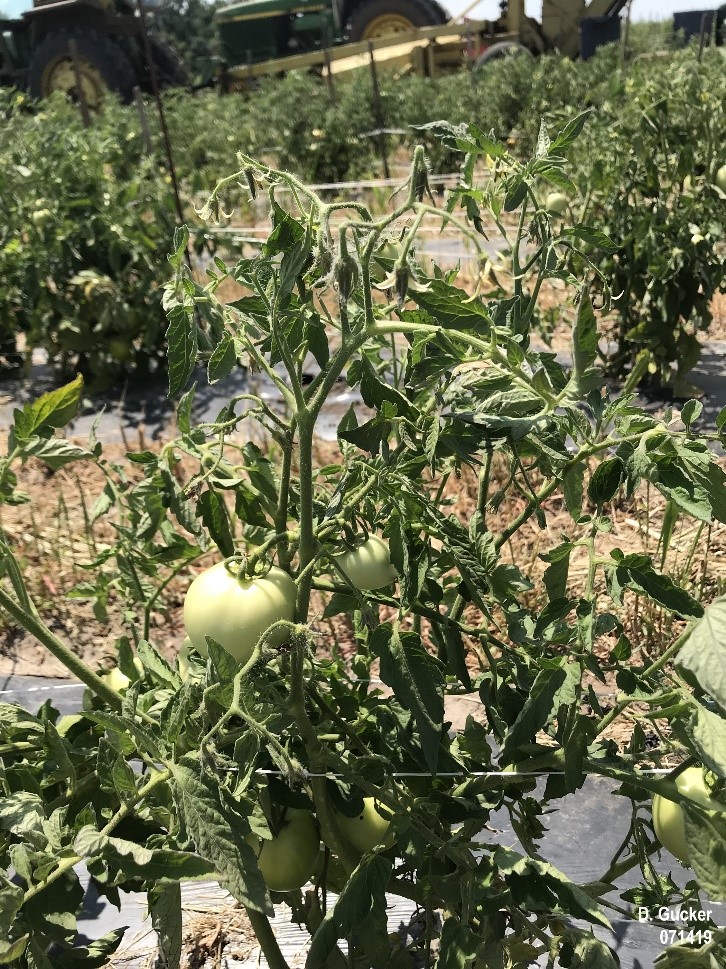
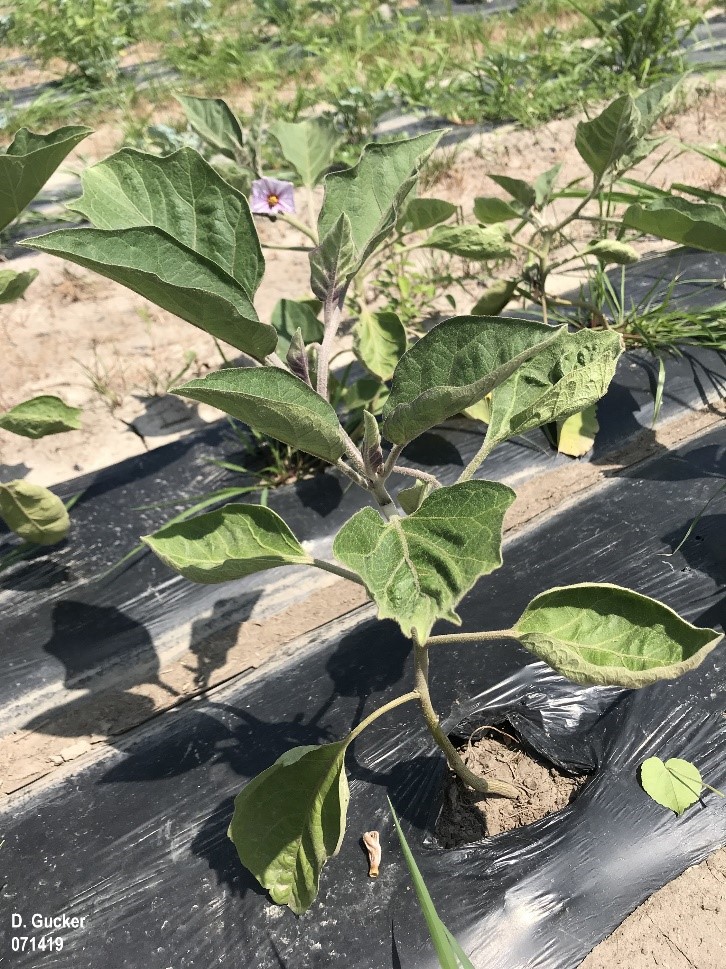
Doug Gucker (217-877-6042; dgucker@illinois.edu)
From the St. Louis Metro East… It is hot and humid in the St Louis Metro east. Heat indices are well into the 100s, making work outside and in poorly ventilated buildings an unpleasant and potentially dangerous activity. The area actually needed rain and remnants of Hurricane Barry delivered a gentle 0.5” before this recent heat wave.
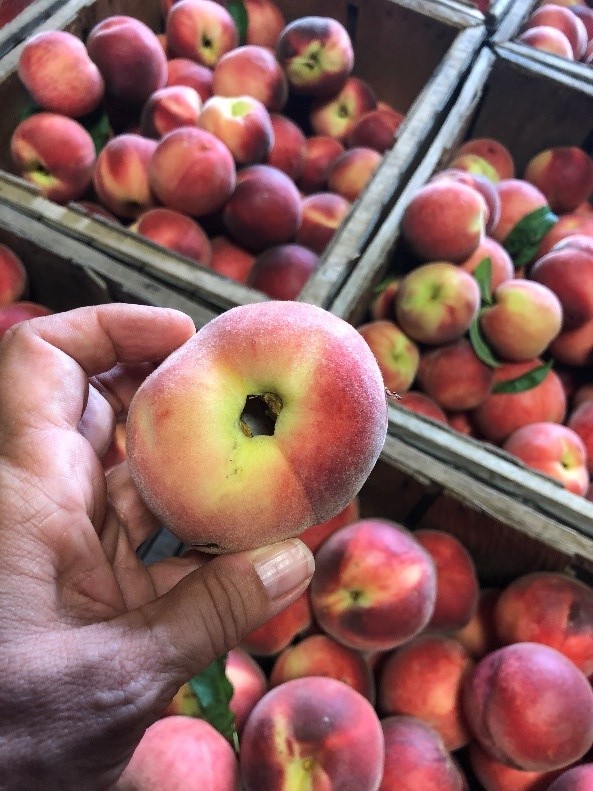
Peach with split pit. Photo credit: E. Wahle
Peach harvest has moved into the Redhaven window and split pits are still in abundance. Peaches with split pits have abnormal openings at the end of the fruit where attached to the shoot, exposing the inside of the fruit to the open environment…rain, oxygen, pathogens, etc. On the tree, fruit with split pits can be singled out because the look larger and tend to ripen sooner. Unfortunately, fruit with split pits also tend to have a shorter shelf-life because of increased disease development in the flesh around the pit due to open exposure to the environment. These are usually sorted out for immediate use other than fresh-eating market. Early-ripening cultivars are generally more likely to develop split pits, but as we have seen this year, can continue to occur in later-season cultivars. The actual splitting of the pit can occur during two periods of development, about 20 days after full bloom while the pit is still soft, or after pit hardening when the expanding flesh along the pit is growing so fast, it exerts enough force to cause the pit to break along its suture. Aside from split pits, the crop continues to look beautiful.
Growers are making the first combing pass to start opening windows to slowly expose grapes to sunlight. This is usually done in two passes so as not to expose fruit too suddenly, which could result in sunburned fruit, which further leads to fruit rots. If not installed already, it is time to get the electric fence up before raccoons and other mammals realize there is a ripening crop in their vicinity. Downy mildew is evident.
Everything vegetable is in harvest, including major crops like tomatoes, sweet corn, cantaloupe, and squash. For such a rough start, the quality is excellent.
Still some road closures due to flooding along the Illinois River (Nutwood Levee District) between Pere Marquette State Park and the Hardin Bridge. The Grafton Ferry is again in operation.
Elizabeth Wahle (618-344-4230; wahle@illinois.edu)
From southern Illinois... It has been hot and humid! We have had temperature in the low to mid 90s but extemely high humidity! We got some welcomed rain last Monday & Tuesday thanks to Hurricane Barry. At my office in Murphysboro we had 2.4” total. It was the nicest rain I have seen it quite a while, a slow, soaking rain. I think it took most of Monday to get the first inch and in the end I think most everying soaked in and very little runoff. As you headed further south the rain got more intense and I heard reports of upwards of 4 inches in some areas. We have more rain chances early next week and along with that a drop in temperature and humidity as well.
Out in the field summer vegetable harvest continues. Many plantings still are struggling with the excessive rainfall from a few weeks before with lots of root rot and disease issues. Pumpkins are really taking off and greatly appreciated the rain! In the orchard growers are nearing the end or Red Havens and peach varieites like Bounty will be next up. Cut flowers are becoming ever more prevalent and one of our local orchards had a unique twist on this. Rendleman’s Orchard has “U-pick zinnias. The field is in full bloom and quite beautiful. These zinnas were no-till drilled into cereal rye. The cowpeas and pearl millet I planted at the office is really taking off now. The cowpeas have good nodulation forming, allowing them to produce nitrogen, that then can be used by future crops.

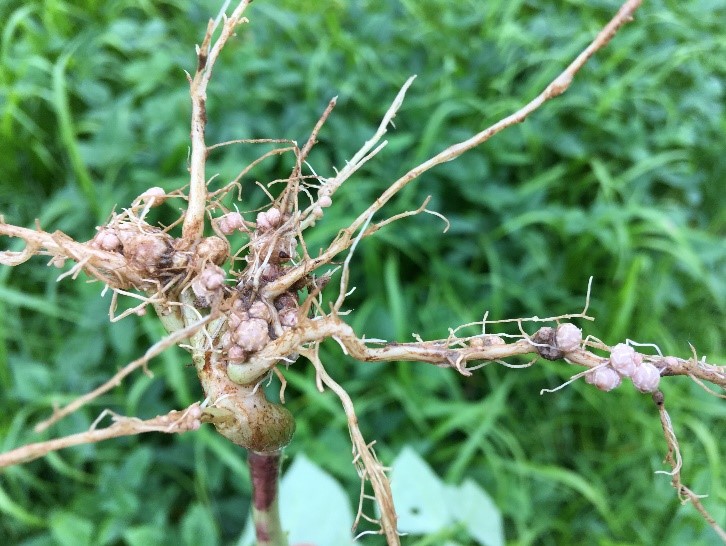
No-till zinnia field at Rendleman Orchard (left). Nodulation of nitrogen fixing bacteria on cowpea cover crop (right). Photos: N. Johanning
Nathan Johanning (618-939-3434; njohann@illinois.edu)
From Dixon Springs Ag Center…Tomato, pepper, and cucumber harvest continue in both of our high tunnels. We are still picking a steady amount of ‘Monterey’ strawberries from the 15 vertical stacks (about 6-8 quarts per week total) and the flavor and quality are still very good. Just the right amount for all of us to eat on each week! We have completed our onion harvest and will probably harvest the celery and celeriac this week.
Major insect pests continue to be army worm and spider mites. We have not observed any flea beetles, tomato worms, or stink bugs yet this season. For those wondering how our tomatoes with White Mold and Gray Mold are doing, we have been able to keep the majority in production and have held the progression at bay, especially on the Gray Mold with 3 applications of Inspire Super fungicide that were made. We also made careful pruning removals of some of the more infected stem areas and leaves. Because the White Mold doesn’t spread between plants and there are no known fungicides that are effective, individual plants have been culled or removed from the planting when they start to wilt or when small black sclerotia structures are visible in dead stem tissue. This calls for daily scouting and decision making, as well as very careful removal so as not to let any of the bodies come in contact with the soil or row middles within the tunnel. In other words, practice very strict sanitation methods.
Also of note, we skinned the third high tunnel last week and have begun preparing it to house winter vegetable production plots for the IDOA Specialty Crop Block grant we received this past year. Stay tuned for future updates.
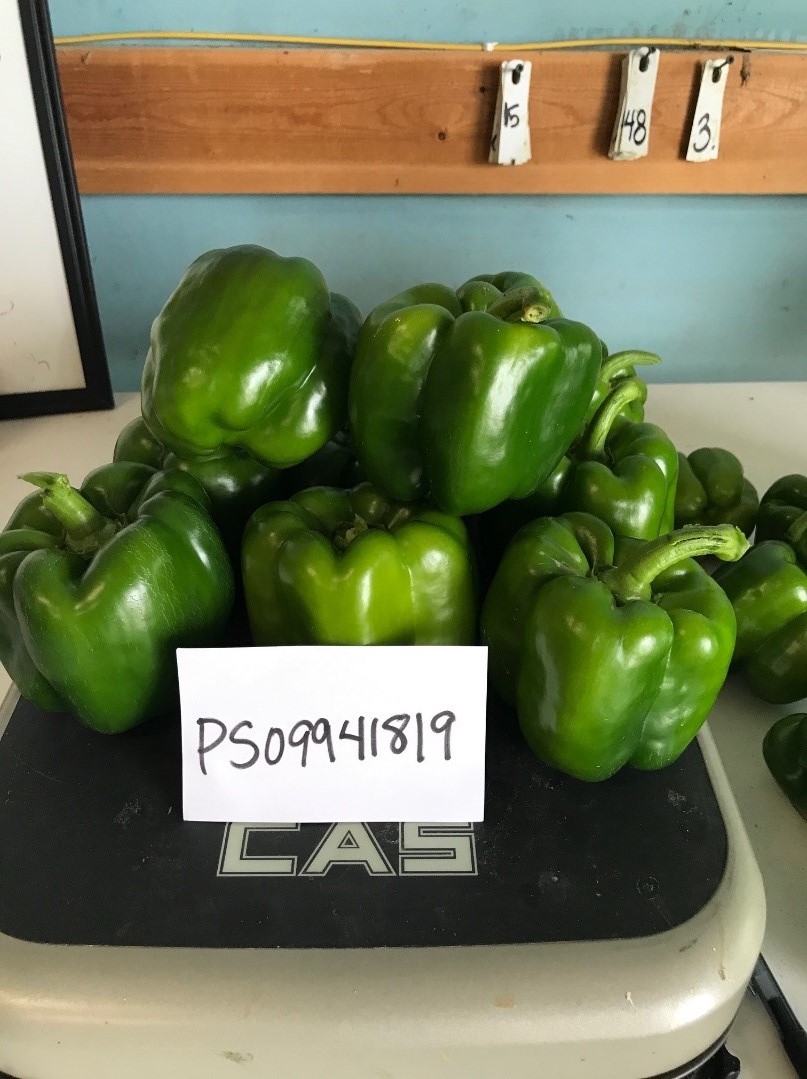
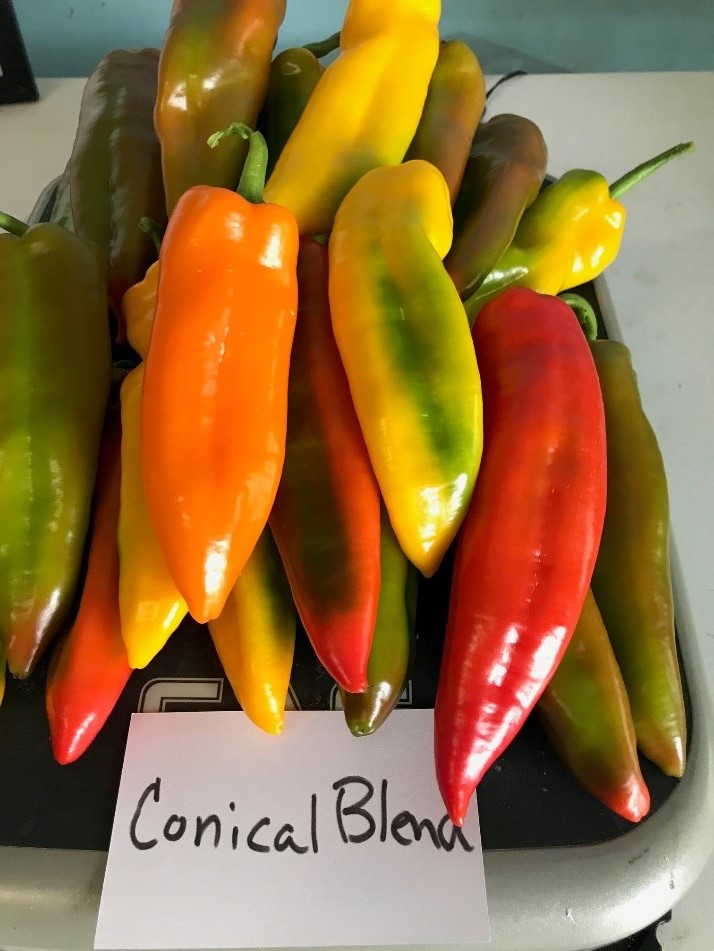
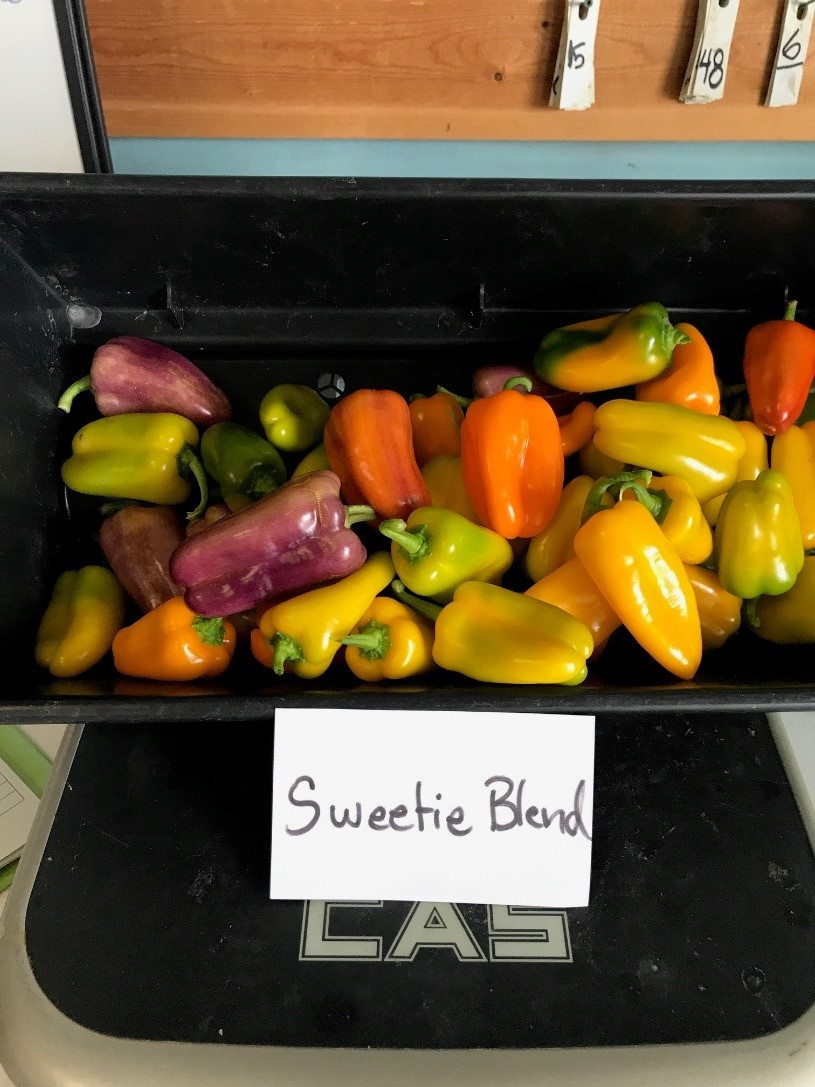
Just a few pictures of some of the different peppers being grown at DSAC in the high tunnels. PS09941819, Conical Blend, and Sweetie Blend are all being grown in in-ground raised beds, along with several other varieties and types of peppers. Photos by B.Aly
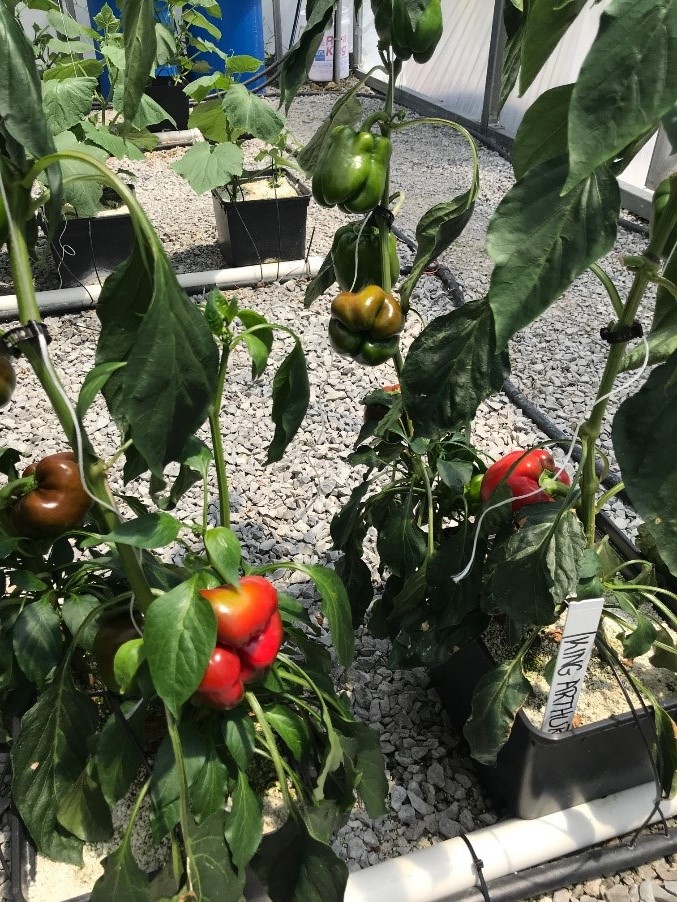

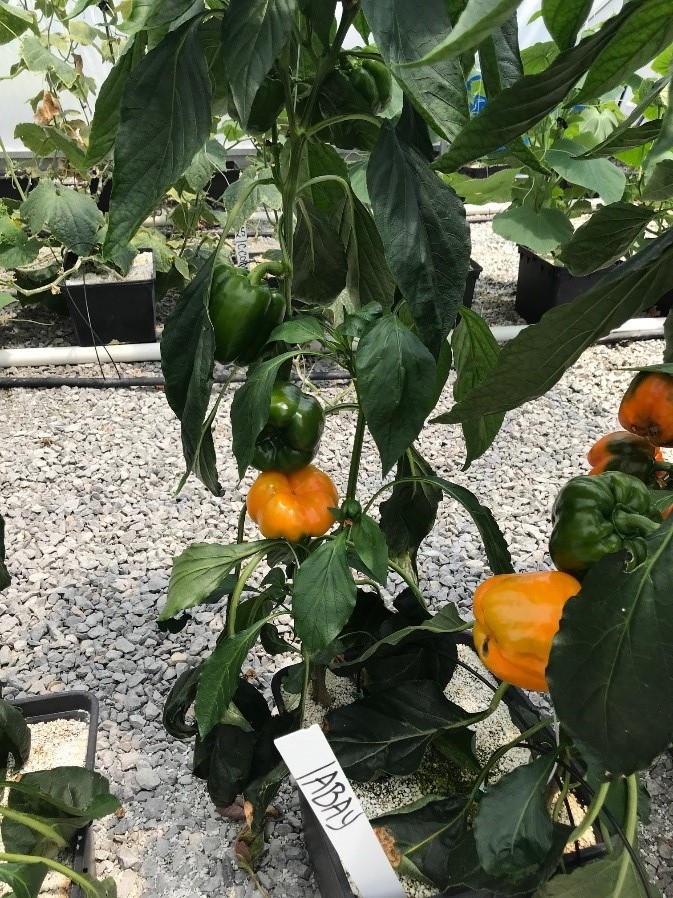
These three bell pepper varieties are being grown hydroponically and trained to a single stem, with suckers being pruned off. ‘Milena’ is a recommended greenhouse pepper variety while ‘King Arthur’, an old commercial standard, does not appear to perform nearly as well…go figure. ‘Milena’ has a very thick wall and ripens to a very vibrant, firm orange fruit of mostly medium size. The spacing of the fruit on both ‘Abay’ and ‘Milena’ seems to be pretty uniform and consistent as well. Photos by B. Aly.
Bronwyn Aly (618-382-2662; baly@illinois.edu)
Fruit and Vegetable Pest Management
New Grape Production Videos
Check out the newest commercial grape production videos from Elizabeth Wahle and Brad Taylor on these topics and more.
2019 Replacing a Broken or Leaning Vineyard Post https://youtu.be/UCdx6f0SdJg
2019 Excluding Raccoons from the Vineyard https://youtu.be/0lS_TV6avKk
2019 Controlling Downy Mildew in the Vineyard https://youtu.be/qaVgJbDAYrA
Elizabeth Wahle (618-344-4230; wahle@illinois.edu)
Pumpkin Disease Management
As we get into the later part of July, now is the time to start scouting more closely for diseases in pumpkins. Powdery mildew is by far the most prevalent and common pumpkin disease, but also bacterial spot and also in some years downy mildew can also blow into the area. However, I have not heard of any reports yet of downy mildew in any cucurbits in the region as of now
To catch powdery mildew early, we want to be scouting the vines and also undersides of leaves which is where it often shows up first. For best control, start a preventative fungicide program, before or as soon as any infection is noted in the field. Often late July or early August is when we would expect to see infections start.
Please see the link below for the current, 2019 pumpkin fungicide recommendations from the research our plant pathologist Dr. Mohammad Babadoost for all of these common pumpkin diseases
https://web.extension.illinois.edu/smallfarm/downloads/80257.pdf
For more information or questions about pumpkin disease management contact Dr. Babadoost at 217-333-1523 or babadoos@illinois.edu
Nathan Johanning (618-939-3434; njohann@illinois.edu)
Less Seriously
https://short-funny.com/
When I see lovers' names carved in a tree, I don't think it's sweet. I just think it's surprising how many people bring a knife on a date.
A doctor accidentally prescribes his patient a laxative instead of a coughing syrup. Three days later the patient comes for a check-up and the doctor asks: “Well? Are you still coughing?” - The patient replies: “No. I’m afraid to.”
An old grandma brings a bus driver a bag of peanuts every day. First the bus driver enjoyed the peanuts but after a week of eating them he asked: "Please granny, don't bring me peanuts anymore. Have them yourself." - The granny answers: "You know, I don't have teeth anymore. I just prefer to suck the chocolate around them."
Guest to the waiter: “Can you bring me what the lady at the next table is having?” - Waiter: “Sorry, sir, but I’m pretty sure she wants to eat it herself.”
University of Illinois Extension Specialists in Fruit and Vegetable Production & Pest Management
Extension Educators – Local Food Systems and Small Farms |
||
Bronwyn Aly, Gallatin, Hamilton, Hardin, Pope, Saline, and White counties |
618-382-2662 |
|
Katie Bell, Franklin, Jackson, Perry, Randolph, & Williamson counties |
618-687-1727 |
|
Sarah Farley, Lake & McHenry counties |
847-223-8627 |
|
Nick Frillman, Woodford, Livingston, & McLean counties |
309-663-8306 |
|
Laurie George, Bond, Clinton, Jefferson, Marion, & Washington counties |
618-548-1446 |
|
Zachary Grant, Cook County | 708-679-6889 | |
Doug Gucker, DeWitt, Macon, and Piatt counties |
217-877-6042 |
|
Erin Harper, Champaign, Ford, Iroquois, and Vermillion counties |
217-333-7672 |
|
Grace Margherio, Jackie Joyner-Kersee Center, St. Clair County |
217-244-3547 |
|
Grant McCarty, Jo Daviess, Stephenson, and Winnebago counties |
815-235-4125 |
|
Katie Parker, Adams, Brown, Hancock, Pike and Schuyler counties |
217-223-8380 |
|
Kathryn Pereira, Cook County |
773-233-2900 |
|
James Theuri, Grundy, Kankakee, and Will counties |
815-933-8337 |
|
Extension Educators – Horticulture |
||
Chris Enroth, Henderson, Knox, McDonough, and Warren counties |
309-837-3939 |
|
Richard Hentschel, DuPage, Kane, and Kendall counties |
630-584-6166 |
|
Andrew Holsinger, Christian, Jersey, Macoupin, & Montgomery counties |
217-532-3941 |
|
Extension Educators - Commercial Agriculture |
||
Elizabeth Wahle, Fruit & Vegetable Production |
618-344-4230 |
|
Nathan Johanning, Madison, Monroe & St. Clair counties |
618-939-3434 |
|
Campus-based Extension Specialists |
||
Kacie Athey, Entomology |
217-244-9916 |
|
Mohammad Babadoost, Plant Pathology |
217-333-1523 |
|